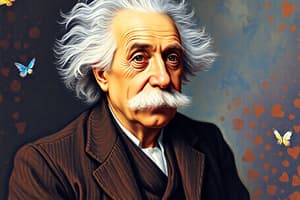Podcast
Questions and Answers
What specific contribution to physics earned Albert Einstein the Nobel Prize in 1921?
What specific contribution to physics earned Albert Einstein the Nobel Prize in 1921?
- Special Theory of Relativity
- General Theory of Relativity
- Explanation of the photoelectric effect (correct)
- Theory of Brownian motion
Which phenomenon did Einstein describe that reflects the existence of atoms in constant motion?
Which phenomenon did Einstein describe that reflects the existence of atoms in constant motion?
- Quantum entanglement
- Photoelectric effect
- Relativity of simultaneity
- Brownian motion (correct)
Which equation represents the equivalence of mass and energy in Einstein's theory of relativity?
Which equation represents the equivalence of mass and energy in Einstein's theory of relativity?
- E = mc² (correct)
- m = E/c
- E = mv
- E = m²c
What is the minimum energy required for the photoelectric effect to occur?
What is the minimum energy required for the photoelectric effect to occur?
Who first documented the concept of the photoelectric effect prior to Einstein?
Who first documented the concept of the photoelectric effect prior to Einstein?
What role do photons play in the photoelectric effect according to Einstein's theory?
What role do photons play in the photoelectric effect according to Einstein's theory?
Which statement best describes the significance of the theory of special relativity?
Which statement best describes the significance of the theory of special relativity?
What was Albert Einstein's profession before becoming a renowned physicist?
What was Albert Einstein's profession before becoming a renowned physicist?
What does the equation E = mc^2 signify about mass and energy?
What does the equation E = mc^2 signify about mass and energy?
Which statement best describes general relativity?
Which statement best describes general relativity?
What happens to an object's mass as it approaches the speed of light according to special relativity?
What happens to an object's mass as it approaches the speed of light according to special relativity?
According to Heisenberg's uncertainty principle, what cannot be determined with absolute accuracy?
According to Heisenberg's uncertainty principle, what cannot be determined with absolute accuracy?
What was Albert Einstein's view on the uncertainty principle?
What was Albert Einstein's view on the uncertainty principle?
When did the term atomic energy first originate, and who popularized it?
When did the term atomic energy first originate, and who popularized it?
What implication does special relativity have about energy as speeds increase?
What implication does special relativity have about energy as speeds increase?
Which of the following best defines atomic energy?
Which of the following best defines atomic energy?
Study Notes
Albert Einstein
- Albert Einstein was a German-born physicist who developed the special and general theories of relativity.
- He won the Nobel Prize for Physics in 1921 for his explanation of the photoelectric effect.
- He is generally considered the most influential physicist of the 20th century.
Brownian Motion
- Brownian motion was first noted in 1827 by Robert Brown, a Scottish botanist.
- Einstein’s theory explained the phenomenon, providing evidence for the existence of atoms in constant motion.
The Photoelectric Effect
- In 1887 Heinrich Hertz documented the photoelectric effect, where electrons are emitted from the surface of metals when exposed to light of sufficient frequency.
- Einstein theorized that when a photon falls on a metal surface, its energy is transferred to an electron.
- This energy is then used to free the electron from the atom, with the remaining energy becoming the electron's kinetic energy.
- The minimum energy needed for the photoelectric effect is 3.0895471249137887 electron volts, or 4.95 x 10-19 joules.
Mass-Energy Equivalence
- Einstein's theory of special relativity demonstrates that mass and energy are equivalent and interchangeable forms of the same entity.
- This concept is expressed the equation E=mc², where E is energy, m is mass and c is the speed of light.
General Relativity
- General relativity, published in 1915, is Einstein's theory of gravity.
- It is a geometric theory that describes gravity as a property of space and time.
- It generalizes special relativity and refines Newton's law of universal gravitation.
Special Relativity
- Einstein's theory of special relativity, published in 1905, is a fundamental principle in physics.
- It explains how speed affects mass, time and space.
- As an object approaches the speed of light, its mass increases infinitely, requiring more energy to move. This makes exceeding the speed of light impossible.
Uncertainty Principle
- The uncertainty principle proposed by Werner Heisenberg states that the position and momentum of an electron cannot be determined simultaneously with absolute accuracy.
- This principle is represented by the equation ΔxΔp ≥ h/2π, where Δx is the uncertainty in position, Δp is the uncertainty in momentum, and h is Planck's constant.
Einstein's Opposition to the Uncertainty Principle
- Einstein disagreed with the uncertainty principle as a fundamental law of physics.
- He believed in a deterministic universe and did not accept the inherent uncertainty in quantum mechanics.
Atomic Energy
- Atomic energy, or energy of atoms, was first theorized by Ernest Rutherford in 1903.
- The phrase "splitting the atom" was popularized by H.G. Wells before the discovery of the atomic nucleus.
Studying That Suits You
Use AI to generate personalized quizzes and flashcards to suit your learning preferences.
Related Documents
Description
This quiz explores the foundational contributions of Albert Einstein, focusing on his theories of relativity, the photoelectric effect, and Brownian motion. Examine his impact on modern physics and understand the significance of his work in 20th-century science.





